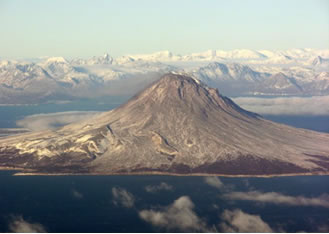
 |
Augustine Volcano stirs from slumberOctober 5, 2007Courtesy of Far North Science 
Augustine on November 18, 2006 Augustine Volcano - a storybook cone that looms 4,134 feet from Lower Cook Inlet on the horizon near Homer, Seldovia and Anchor Point - has blown its top five times in the past half century, most recently in January 2006. This time, a series of tiny earthquakes began trembling within the massif beneath the summit, possibly suggesting that a blob of viscous magma was wrenching and oozing through solid rock. On Sept. 22, AVO raised the aviation warning code to yellow and issued an advisory to the general public. "The current earthquakes are small, generally less than magnitude 1.0, and are located at shallow depth beneath the volcano's summit," the observatory said in its original message. "While significant, the current earthquake activity is much less energetic than that which immediately preceeded the explosive eruptions in January 2006." But Augustine continues to grumble, and AVO has issued additional statements every day since. Located 180 miles southeast of Anchorage and 75 miles southwest of Homer, Augustine out rumbles its much larger cousins in the Cook Inlet volcano family, sometimes blasting clouds of ash eight miles high. "Historically, Augustine is the most active volcano in the Cook Inlet region with significant eruptions in 1812, 1883, 1935, 1963-64, 1976, 1986, and 2006," AVO writes. "These eruptions were primarily explosive events that produced volcanic ash clouds (to 30,000-40,000 feet above sea level), ash fall, pyroclasic flows, and and lava domes or flows. During the 1883 eruption, a large avalanche on the north flank of the volcano flowed into Cook Inlet and may have initiated a tsunami observed at Nanwalek, about 90 km to the east." Including those major blows, Augustine has erupted at least 17 times since 1812, including the latest that began in 2005. The last eruptive period launched in the fall of 2005 and ended in March of 2006. And now it wakes again. (Or not.) Since Sept. 22, the volcano has been trembling with small earthquakes, occasionally punctuating its tossing and turning with bursts of activity. Monitoring the seismic heartbeat of a volcano is one way that volcanologists track the movement of magma and gas deep within. "Shallow, low-level seismic activity continues," AVO wrote on Oct. 4. "Web camera and satellite images of the volcano are cloudy today." Sometimes the volcano will slip back into deep slumber without blowing its top or burbling lava down its flanks. Stay tuned. The Alaska Volcano Observatory operates one of the most interesting natural science websites in the Far North, complete with a volcano atlas, histories, gobs of photos, webcams and real-time seismographs that offer fleeting glimpses into the home planet's subterranean turmoil. |
> |